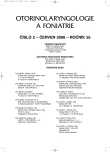Sérové hladiny IL-2, IL-4, IL-10 a TGFβ1 a jejich srovnání s markery angiogeneze a apoptózy u karcinomů a chronického zánětu patrové mandle
Serum Levels of IL-2, IL-4, IL-10 and IGFß1 and their Comparison with Markers of Angiogenesis and Apoptosis in Carcinoma and Chronic Inflammation of Tonsil
Introduction:
The present time the immune and defense mechanisms going on during pathological processes in relation to the origin and development of tumors are under study. In the course of inflammation, cytokines Th1-Th2 are releases and their relation to tumor transformation have especially recently become the subject of investigation. The relation of cytokines and information molecules, including the growth factors, to spinocellular carcinoma of head and neck and their relation to lymphatic tissue or Th1-Th2 to lymphomas, has not been studied yet.
Objective:
To determine the role of cytokines in the pathogenesis of oropharngeal tumors
Methods:
The concentration of cytokines IL-2, IL-4, IL-10 and TGFß1 were examined from blood serum taken from patients suffering from cancroid carcinoma of the tonsil (N=17) and patients before the operation on chronic inflammation of the tonsils (N=11). The determination of cytokines was performed by the method of ELISA (Dako Kit) with controls (doublets) in blood serum. Apoptosis was examined immunohistochemically in sampled tumor tissue of the tonsil tumor or the tonsil with chronic inflammation by means of the markers of caspase 3 an Ki67. The authors also detected the activity of eNOS (endothelial NO synthase). The individual markers were determined by the three-step procedure using antibodies labeled with Vactastain ABC Elite and the diaminobenzidine stain. SA statistical analysis was performed by Mann-Whitney test, after testing comparability of the groups.
Results:
In the patient with the tonsil cancer, the levels of IL-10 (8.97 pg/ml, STD 13.76 pg/ml) and IGFß1 (89.75 ng/ml, STD 98.35 ng/ml), in patients with chronic tonsil inflammation the values were 2.95 pg/ml, STD 23.08 pg/ml) and IGFß1 (49.61 ng/ml, STD 29.54 ng/ml).
Conclusion:
The presented data have demonstrated the expression of Ki67, apoptosis (caspase 3), angiogenesis (eNOS) and expression of cytokines IL-10 and TGFß1 in the tissues affected by chronic inflammation of the tonsil as well as the spinocellular carcinoma of the tonsil. It is therefore possible to hypothesize that chronic inflammation may potentiate or participate in tumor transformation of the cells in the tonsil tissue.
Key words:
chronic inflammation, oropharynx, tumors, cytokines, apoptosis, growth factors.
Autoři:
J. Astl 1; D. Veselý 1; T. Kučera 2; J. Martínek 2; H. Pácová 1,2; I. Šterzl 3; J. Betka 1
Působiště autorů:
Klinika otorinolaryngologie a chirurgie hlavy a krku l. LF UK a FN Motol, Praha
1; Ústav histologie a embryologie l. LF UK, Praha
2; Ústav mikrobiologie a imunologie l. LF UK, Praha
3
Vyšlo v časopise:
Otorinolaryngol Foniatr, 55, 2006, No. 2, pp. 88-91.
Kategorie:
Původní práce
Souhrn
Úvod:
V současnosti jsou zkoumány imunitní a obranné mechanismy v průběhu patologických procesů ve vztahu ke vzniku a vývoji nádorů. V průběhu zánětů jsou uvolňovány cytokiny Th1-Th2 a jejich vztah k nádorové transformaci je především v poslední době předmětem výzkumu. Vztah cytokinů a informačních molekul, včetně růstových faktorů ke spinocelulárním karcinomům hlavy a krku a jejich vztah k lymfatické tkáni, resp. Th1-Th2 lymfocytům nebyl dosud studován.
Cíl práce:
Zjištění úlohy cytokinů v patogenezi nádorů orofaryngu.
Metodika:
Koncentrace cytokinů IL-2, IL-4, IL-10 a TGFβ1 byly vyšetřeny z krevního séra odebraného nemocným s dlaždicovým karcinomem patrové mandle (N=17) a nemocným před operací pro chronický zánět patrových mandlí (N=11). Stanovení cytokinů bylo provedena metodou ELISA (Dako Kit) s kontrolami (dublety) v krevním séru. Apoptóza byla stanovena imunohistochemicky v odebrané tkáni nádoru patrové mandle či mandle s chronickým zánětem pomocí markerů kaspázy 3 a Ki67. Dále byla detekována aktivita eNOS (endotelová NO syntáza). Jednotlivé markery byly stanoveny třístupňovým postupem protilátkami, které byly značeny Vectastain ABC Elite a barvivem diaminobenzidine. Statistická analýza byla provedena Mann-Whitneyovým testem po otestování komparability souborů.
Výsledky:
U nemocných s karcinomem patrové mandle byly zjištěny hladiny IL-10 (8,97 pg/ml std. 13,76 pg/ml) a TGFβ1 (89,75 ng/ml std 98,35 ng/ml), u nemocných s chronickým zánětem patrové mandle byly zjištěny hladiny IL-10 (2,95 pg/ml std. 3,08 pg/ml) a TGFβ1 (49,61 ng/ml std 29,54 ng/ml).
Závěr:
V předložené práci byly prokázány exprese Ki67, apoptózy (kaspáza 3), angiogeneze (eNOS) a exprese cytokinů IL-10 a TGFβ1 ve tkáních chronického zánětu patrové mandle a spinocelulárního karcinomu patrové mandle. Lze proto vyslovit hypotézu, že chronický zánět může potencovat nebo se podílet na nádorové transformaci buněk ve tkáních patrové mandle.
Klíčová slova:
chronický zánět, nádory orofaryngu, cytokiny, apoptóza, růstové faktory.
Štítky
Audiologie a foniatrie Dětská otorinolaryngologie OtorinolaryngologieČlánek vyšel v časopise
Otorinolaryngologie a foniatrie

2006 Číslo 2
Nejčtenější v tomto čísle
- Tonzilektómie za tepla a za studena
- Uzlinové krční metastázy spinocelulárního karcinomu orofaryngu a hrtanu (2. část)
- Slizniční melanomy hlavy a krku
- Chirurgická léčba cholesteatomu
